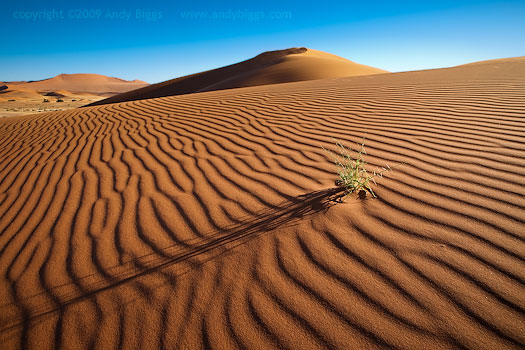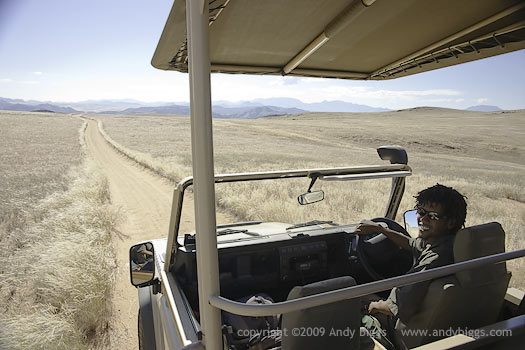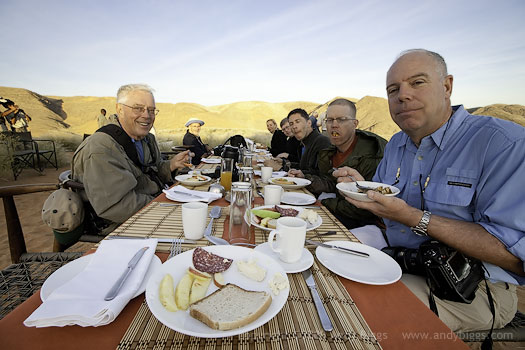Ok, so I have been back home for almost a month and I have had the time to reflect on my latest Africa adventure. So here are some thoughts about my trip, along with a few behind the scenes type images.
This was my 3rd trip to Namibia since 2006, and I had 2 different itineraries and groups this time around. The first segment was all about the northern and central part of Namibia, and we spent our time at 3 different camps/locations: Skeleton Coast Camp, Serra Cafema along the Kunene River which borders Angola and Kulala Desert Lodge near Sossusvlei, Deadvlei and the tall sand dunes of the Namib-Naukluft Park. The second segment of my Namibia journey focused on the central and southern part of Namibia: Kulala Desert Lodge and the Namib-Naukluft Park (same as 1st trip), the unique landscapes of the Namib Rand Reserve and Woldedans Dunes Lodge, and the deserted diamond mining town of Kolmanskop.
All of my photography on this trip was taken with gear that was graciously on loan from Sony, and the kit included a pair of A900 24mp camera bodies with portrait grips, a 16-35mm f/2.8 Zeiss, 24-70mm f/2.8 Zeiss and a 70-400mm f/4-5.6 G lens. They had also sent a few other lenses, but due to weight restrictions I needed to travel with the most efficient kit possible. I really enjoyed this Sony kit, and for travel and landscape photographers I cannot think of a better system at the moment. The A900 camera is a well-built yet small camera, and the lenses are as good as any that I have used from Canon and Nikon. There is much to like about the entire system, and I am taking notice of their super telephoto that they had behind glass at this year's PMA in Las Vegas. Based on the size I can only surmize that it will be a 500mm f/4, and hope that I will be able to get my hands on it when it is available. Joe Johnson of Really Right Stuff also loaned me an L bracket for the A900, and I want to publicly say thank you to both Sony and RRS for the loaners for the trip.
This first segment was a joint operation between myself and John Paul Caponigro, and we had 10 participants. Due to the distances involved, we used bush planes to transport us, our camera gear and our luggage between our camps. Even though we did not expect it, we had an additional Cessna 210 to augment our Cessna Grand Caravan. Some of the flights were quite long, and when flying over such beautiful terrain I had to remind myself to have enough compact flash cards for these flights, as it is easy to burn through 8GB or more on a single flight.

Running down the dunes. Sony A900, 24-70mm, 1/50 @ f/8, ISO 100
Our first camp was Skeleton Coast Camp, and on the way there we made a landing at Palmwag in the Damaraland region for fueld and a 'bio break'. The flight from Palmwag to Skeleton Coast was spectacular, as the rocky hills of Damaraland turned into bleached sand dunes along the coast. Wilderness Safaris operates the camp at the Skeleton Coast, and they have exclusive use of the entire Skeleton Coast National Park. Imagine having an entire national park all to yourself, and we pretty much had this during our stay as there were very few people at the camp when we were there. We spent 3 nights at Skeleton Coast Camp, and we only saw a small portion of what the area has to offer.
The Skeleton Coast National Park is only a small subset over the skeleton coast, as the entire coast of Namibia is considered the skeleton coast. The area is rich with many different types of eco-zones, and literally every 30 minutes you see an area that was totally different than the last. The area can get warm during the day if it has clear skies, but the closer you are to the ocean the more likely that you are going to encounter some sort of coastal fog. This brings cool air, along with an increase in wind speeds. Each morning before sunrise the temperatures were in the 40's, and on some afternoons it would get into the upper 80's. I am dying to get back to the Skeleton Coast, but John Paul is going to beat me to the punch as he will be leading a trip there in 2010 (email me if you are interested in being put on a list to be notified when we have more information).
Here some grab shots from our time there:
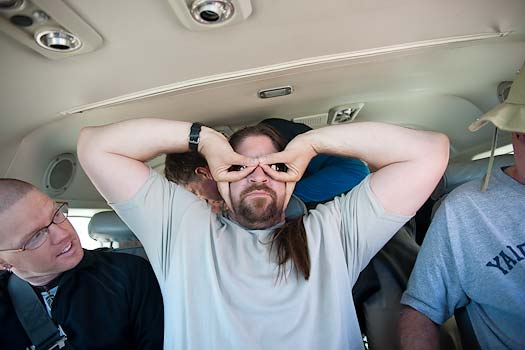
JP gives us his best superhero imitation
 Larry striking a pose. Sony A900, 24-70mm, 1/80 @ f/5.0, ISO 100
Larry striking a pose. Sony A900, 24-70mm, 1/80 @ f/5.0, ISO 100

The wildlife in Namibia is scare, but fabulous. Springbok near the Hoarusib River. Sony A900, 70-400mm, 1/640 @ f/8, ISO 200
 Justin cannot exactly take a nap when JP is taking wide angle shots of his feet. Sony A900, 16-35mm, 1/320 @ f/4, ISO 100
Justin cannot exactly take a nap when JP is taking wide angle shots of his feet. Sony A900, 16-35mm, 1/320 @ f/4, ISO 100
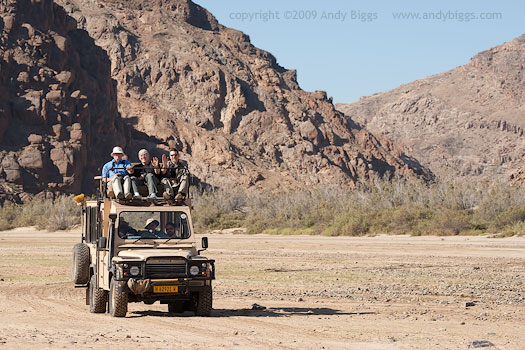 The Skeleton Coast Camp vehicles have a bench seat on the top. Very cool for getting a (windy) view of the terrain. I loved sitting up on top, as I soaked in all of the views and smells of the area. This is an experience that is not to be missed, for sure. Sony A900, 70-400mm, 1/250 @ f/8, ISO 100
The Skeleton Coast Camp vehicles have a bench seat on the top. Very cool for getting a (windy) view of the terrain. I loved sitting up on top, as I soaked in all of the views and smells of the area. This is an experience that is not to be missed, for sure. Sony A900, 70-400mm, 1/250 @ f/8, ISO 100
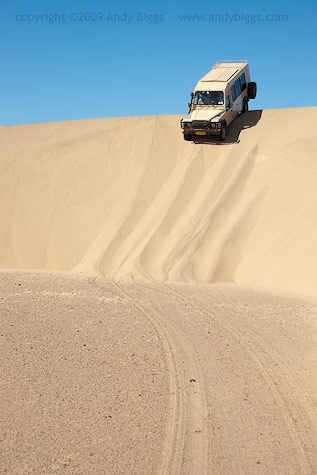 Part of the Namibia offroad driving experience is the traversing of dunes. This isn't a particularly tall dune, but it does give a clue as the angle of descent that we would often face. As you drive, or more accurately slide, down the sand dune roars at you as a result of the friction. Sony A900, 24-70mm, 1/500 @ f/5.6, ISO 100
Part of the Namibia offroad driving experience is the traversing of dunes. This isn't a particularly tall dune, but it does give a clue as the angle of descent that we would often face. As you drive, or more accurately slide, down the sand dune roars at you as a result of the friction. Sony A900, 24-70mm, 1/500 @ f/5.6, ISO 100
 ....and taken from another angle on a separate dune. Sony A900, 24-70mm, 1/200 @ f/9, ISO 100
....and taken from another angle on a separate dune. Sony A900, 24-70mm, 1/200 @ f/9, ISO 100
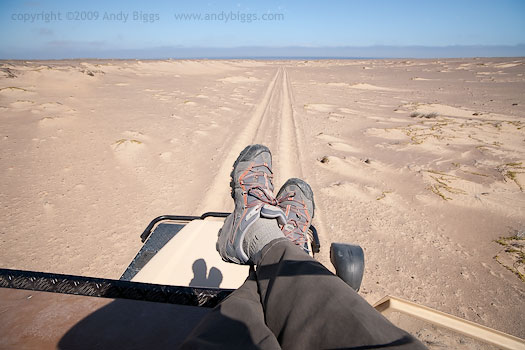 Andy's relaxed pose from on top of the Land Rover. Sony A900, 16-35mm, 1/160 @ f/9, ISO 100
Andy's relaxed pose from on top of the Land Rover. Sony A900, 16-35mm, 1/160 @ f/9, ISO 100
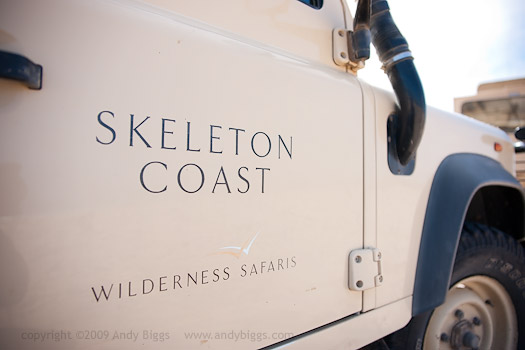 One of our vehicles. Sony A900, 24-70mm, 1/500 @ f/2.8, ISO 100
One of our vehicles. Sony A900, 24-70mm, 1/500 @ f/2.8, ISO 100
 After a long morning of driving and rich photography, we turned the corner and saw that the camp had setup a wonderful lunch right on the beach. I love it when we are able to do these types of meals, as it allows us to stay out all day and not think about returning to camp just to eat a meal. The meals are always wonderful, and when the extra step is taken to exceed expectations it is always well received. Sony A900, 24-70mm, 1/500 @ f/6.3, ISO 100
After a long morning of driving and rich photography, we turned the corner and saw that the camp had setup a wonderful lunch right on the beach. I love it when we are able to do these types of meals, as it allows us to stay out all day and not think about returning to camp just to eat a meal. The meals are always wonderful, and when the extra step is taken to exceed expectations it is always well received. Sony A900, 24-70mm, 1/500 @ f/6.3, ISO 100
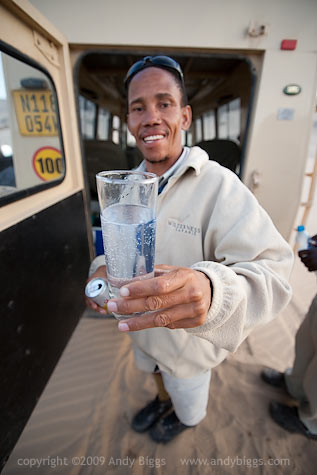 Gert, one of our exceptional guides, offers a cool and refreshing gin and tonic at the end of the day. Sony A900, 16-35mm, 1/500 @ f/2.8, ISO 400
Gert, one of our exceptional guides, offers a cool and refreshing gin and tonic at the end of the day. Sony A900, 16-35mm, 1/500 @ f/2.8, ISO 400
 The Rock Garden and Clouds. Sony A900, 24-70mm, 1/20 @ f/8, ISO 100
The Rock Garden and Clouds. Sony A900, 24-70mm, 1/20 @ f/8, ISO 100
 Friday, August 7, 2009 at 10:38PM
Friday, August 7, 2009 at 10:38PM 







